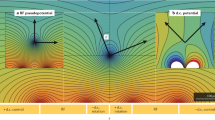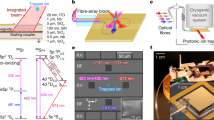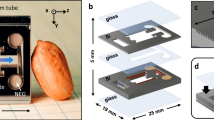Abstract
Laser-cooled atoms are central to modern precision measurements1,2,3,4,5,6. They are also increasingly important as an enabling technology for experimental cavity quantum electrodynamics7,8, quantum information processing9,10,11 and matter–wave interferometry12. Although significant progress has been made in miniaturizing atomic metrological devices13,14, these are limited in accuracy by their use of hot atomic ensembles and buffer gases. Advances have also been made in producing portable apparatus that benefits from the advantages of atoms in the microkelvin regime15,16. However, simplifying atomic cooling and loading using microfabrication technology has proved difficult17,18. In this Letter we address this problem, realizing an atom chip that enables the integration of laser cooling and trapping into a compact apparatus. Our source delivers ten thousand times more atoms than previous magneto-optical traps with microfabricated optics and, for the first time, can reach sub-Doppler temperatures. Moreover, the same chip design offers a simple way to form stable optical lattices. These features, combined with simplicity of fabrication and ease of operation, make these new traps a key advance in the development of cold-atom technology for high-accuracy, portable measurement devices.
This is a preview of subscription content, access via your institution
Access options
Subscribe to this journal
Receive 12 print issues and online access
$259.00 per year
only $21.58 per issue
Buy this article
- Purchase on Springer Link
- Instant access to full article PDF
Prices may be subject to local taxes which are calculated during checkout





Similar content being viewed by others
References
Takamoto, M., Hong, F-L., Higashi, R. & Katori, H. An optical lattice clock. Nature 435, 321–324 (2005).
Deutsch, C. et al. Spin self-rephasing and very long coherence times in a trapped atomic ensemble. Phys. Rev. Lett. 105, 020401 (2010).
Buning, G. K. et al. Extended coherence time on the clock transition of optically trapped rubidium. Phys. Rev. Lett. 106, 240801 (2011).
Bodart, Q. et al. A cold atom pyramidal gravimeter with a single laser beam. Appl. Phys. Lett. 96, 134101 (2010).
Poli, N. et al. Precision measurement of gravity with cold atoms in an optical lattice and comparison with a classical gravimeter. Phys. Rev. Lett. 106, 038501 (2011).
Lamporesi, G., Bertoldi, A., Cacciapuoti, L., Prevedelli, M. & Tino, G. M. Determination of the Newtonian gravitational constant using atom interferometry. Phys. Rev. Lett. 100, 050801 (2008).
Specht, H. P. et al. A single-atom quantum memory. Nature 473, 190–193 (2011).
Ritter, S. et al. An elementary quantum network of single atoms in optical cavities. Nature 484, 195–201 (2012).
Bakr, W. S. et al. Probing the superfluid-to-Mott insulator transition at the single-atom level. Science 329, 547–550 (2010).
Sherson, J. F. et al. Single-atom-resolved fluorescence imaging of an atomic Mott insulator. Nature 467, 68–72 (2010).
Weimer, H., Müller, M., Lesanovsky, I., Zoller, P. & Büchler, H. P. A Rydberg quantum simulator. Nature Phys. 6, 382–388 (2010).
Müller, H., Peters, A. & Chu, S. A precision measurement of the gravitational redshift by the interference of matter waves. Nature 463, 926–930 (2010).
Knappe, S. et al. A microfabricated atomic clock. Appl. Phys. Lett. 85, 1460–1462 (2004); actual products at www.symmetricom.com.
Shah, V., Knappe, S., Schwindt, P. D. D. & Kitching, J. Subpicotesla atomic magnetometry with a microfabricated vapour cell. Nature Photon. 1, 649–652 (2007).
Van Zoest, T. et al. Bose–Einstein condensation in microgravity. Science 328, 1540–1543 (2010).
Reichel, J. & Vuletić, V. (eds) Atom Chips (Wiley, 2011).
Pollock, S., Cotter, J. P., Laliotis, A. & Hinds, E. A. Integrated magneto-optical traps on a chip using silicon pyramid structures. Opt. Express 17, 14109–14114 (2009).
Pollock, S., Cotter, J. P., Laliotis, A., Ramirez-Martinez, F. & Hinds, E. A. Characteristics of integrated magneto-optical traps for atom chips. New J. Phys. 13, 043029 (2011).
Raab, E. L., Prentiss, M., Cable, A., Chu, S. & Pritchard, D. E. Trapping of neutral sodium atoms with radiation pressure. Phys. Rev. Lett. 59, 2631–2634 (1987).
Hänsel, W., Hommelhoff, P., Hänsch, T. W. & Reichel, J. Bose–Einstein condensation on a microelectronic chip. Nature 413, 498–501 (2001).
Schumm, T. et al. Matter–wave interferometry in a double well on an atom chip. Nature Phys. 1, 57–62 (2005).
Baumgärtner, F. et al. Measuring energy differences by BEC interferometry on a chip. Phys. Rev. Lett. 105, 243003 (2010).
Riedel, M. F. et al. Atom-chip-based generation of entanglement for quantum metrology. Nature 464, 1170–1173 (2010).
ColdQuanta; available at http://www.coldquanta.com.
Lee, K. I., Kim, J. A., Noh, H. R. & Jhe, W. Single-beam atom trap in a pyramidal and conical hollow mirror. Opt. Lett. 21, 1177–1179 (1996).
Vangeleyn, M., Griffin, P. F., Riis, E. & Arnold, A. S. Single-laser, one beam, tetrahedral magneto-optical trap. Opt. Express 17, 13601–13608 (2009).
Vangeleyn, M., Griffin, P. F., Riis, E. & Arnold, A. S. Laser cooling with a single laser beam and a planar diffractor. Opt. Lett. 35, 3453–3455 (2010).
Lindquist, K., Stephens, M. & Wieman, C. E. Experimental and theoretical study of the vapor-cell Zeeman optical trap. Phys. Rev. A 46, 4082–4090 (1992).
Dalibard, J. & Cohen-Tannoudji, C. Laser cooling below the Doppler limit by polarisation gradients: simple theoretical models. J. Opt. Soc. Am. B 6, 2023–2045 (1989).
Bloch, I., Dalibard, J. & Nascimbène, S. Quantum simulations with ultracold quantum gases. Nature Phys. 8, 267–276 (2012).
Reichel, J., Hänsel, W. & Hänsch, T. W. Atomic micromanipulation with magnetic surface traps. Phys. Rev. Lett. 83, 3398–3401 (1999).
Acknowledgements
The authors acknowledge support from EPSRC, a Knowledge Transfer account for C.N. and a support fund for J.C. and also the ESA (through ESTEC project TEC-MME/2009/66), CEC FP7 (through project 247687; AQUTE), the Wellcome Trust (089245/Z/09/Z), NPL's strategic research programme and the UK National Measurement Office. P.G. is supported by the Royal Society of Edinburgh and E.H. by the Royal Society. Chip A was fabricated by Mir Enterprises. The authors thank P. Edwards for assistance with the SEM insets in Fig. 2a,b. All other SEM images in Fig. 2 are courtesy of Kelvin Nanotechnology, who fabricated chips B–D at the James Watt Nanofabrication Centre. The authors also thank J.P. Griffith and G.A.C. Jones for assistance with GaAs electron-beam lithography.
Author information
Authors and Affiliations
Contributions
C.N., M.V., P.G., E.R. and A.A. constructed and maintained the apparatus. C.N., J.C. and A.A. collected the data, which was analysed by J.C. and A.A. Chip A was designed by J.C. and E.H. Chips B–D were designed by E.R. and A.A., with fabrication directed by P.S., A.S. and C.I. The manuscript was written by J.C., E.H. and A.A., with comments from all authors.
Corresponding authors
Ethics declarations
Competing interests
The authors declare no competing financial interests.
Supplementary information
Supplementary information
Supplementary information (PDF 354 kb)
Supplementary information
Supplementary information (GIF 2921 kb)
Rights and permissions
About this article
Cite this article
Nshii, C., Vangeleyn, M., Cotter, J. et al. A surface-patterned chip as a strong source of ultracold atoms for quantum technologies. Nature Nanotech 8, 321–324 (2013). https://doi.org/10.1038/nnano.2013.47
Received:
Accepted:
Published:
Issue Date:
DOI: https://doi.org/10.1038/nnano.2013.47
This article is cited by
-
A cold-atom Ramsey clock with a low volume physics package
Scientific Reports (2024)
-
Photonic integrated beam delivery for a rubidium 3D magneto-optical trap
Nature Communications (2023)
-
Integrating planar photonics for multi-beam generation and atomic clock packaging on chip
Light: Science & Applications (2023)
-
A compact cold-atom interferometer with a high data-rate grating magneto-optical trap and a photonic-integrated-circuit-compatible laser system
Nature Communications (2022)
-
Demonstration of a MOT in a sub-millimeter membrane hole
Scientific Reports (2021)



